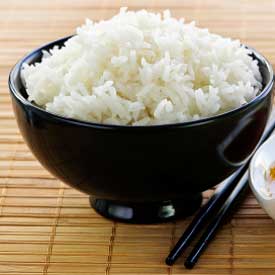 Eating more white rice may increase the risk of type 2 diabetes, especially for Asian populations, Qi Sun, PhD, of Harvard and colleagues reported in the British Medical Journal. Patients who ate the greatest amounts of the grain had a 27% greater risk of developing the disease than those who ate the least, and the relative risk was higher among Asian patients.
Eating more white rice may increase the risk of type 2 diabetes, especially for Asian populations, Qi Sun, PhD, of Harvard and colleagues reported in the British Medical Journal. Patients who ate the greatest amounts of the grain had a 27% greater risk of developing the disease than those who ate the least, and the relative risk was higher among Asian patients.
"Although rice has been a staple food in Asian populations for thousands of years, this transition [to more sedentary lifestyles and greater availability of food] may render Asian populations more susceptible to the adverse effects of high intakes of white rice, as well as other sources of refined carbohydrates, such as pastries, white bread, and sugar sweetened beverages," they wrote.
The glycemic index of white rice is higher than that of other whole grains, largely due to processing. It's also the primary contributor to dietary glycemic load for populations that consume rice as a staple food, such as Asians. Sun and colleagues conducted a meta-analysis of four prospective cohort analyses in Asian and Western populations, totaling 352,384 patients with follow-up ranging from 4 to 22 years.
Overall, Sun and colleagues found a positive association between white rice intake and type 2 diabetes, which was stronger in Asian populations. Asians with the highest intake had a 55% greater risk of diabetes than Asian patients who ate the least rice. The risk was also heightened in Western populations, but the confidence interval was not significant..
In secondary analyses, the association appeared to be more pronounced in women than in men, they added.
They cautioned, however, that the meta-analysis was limited by the observational nature of the included studies and by their reliance on food frequency questionnaires to assess dietary intake. Also, they did not analyze consumption of brown rice, since only one of the four studies examined this food.
In an accompanying editorial, Bruce Neal, MD, of the University of Sydney in Australia, cautioned that the "interpretation of the observed association, and, in particular, determination of the likelihood of causality, are problematic." Neal warned that the highest and lowest levels of rice intake varied greatly between studies, and that what's really needed is a "more sophisticated analysis based on primary rather than summary data." Hopefully, we will have better research tools in the future to better assess dietary factors.
Hu EA, et al "White rice consumption and risk of type 2 diabetes: meta-analysis and systematic review" BMJ 2012; DOI: 10.1136/bmj.e1454.
Neal B "White rice and risk of type 2 diabetes" BMJ 2012; DOI: 10.1136/bmj.e2021.

Comments